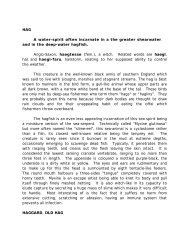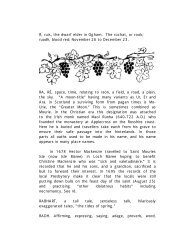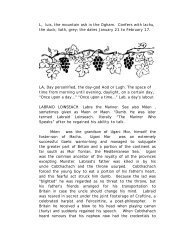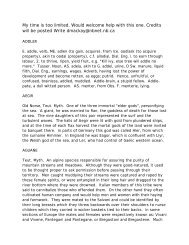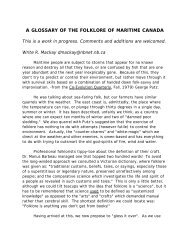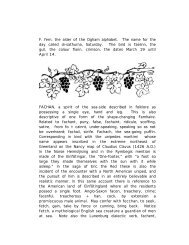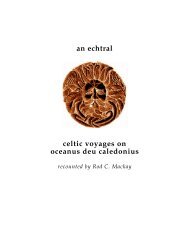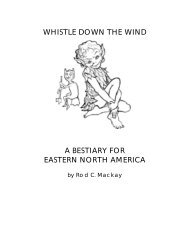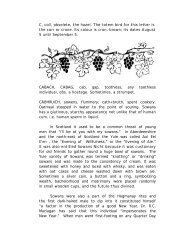G, GORT, ivy in the Ogham alphabet. The bird ... - Rodney Mackay
G, GORT, ivy in the Ogham alphabet. The bird ... - Rodney Mackay
G, GORT, ivy in the Ogham alphabet. The bird ... - Rodney Mackay
Create successful ePaper yourself
Turn your PDF publications into a flip-book with our unique Google optimized e-Paper software.
air. When <strong>the</strong> dark barren days of w<strong>in</strong>ter come and you want<br />
to br<strong>in</strong>g back <strong>the</strong> sun and fruitful fields, you enact <strong>the</strong> birth<br />
of <strong>the</strong> new year by kill<strong>in</strong>g and <strong>the</strong>n restor<strong>in</strong>g life to an actor<br />
who represents life itself. And every "guisers play consists<br />
of three parts that symbolize <strong>the</strong> death of <strong>the</strong> old year and<br />
<strong>the</strong> birth of <strong>the</strong> new one - a fight, <strong>the</strong> death of <strong>the</strong> hero and<br />
his restoration to life."<br />
It has been guessed that <strong>the</strong> first guiser-plays were<br />
<strong>in</strong>stituted at <strong>the</strong> Samha<strong>in</strong>, but <strong>the</strong> lowland Scots tend to<br />
follow <strong>the</strong> notice that "What is played at Yule is also useful<br />
at Pasch (Easter)." In Galloway <strong>the</strong> guisers are known as<br />
<strong>the</strong> Yule boys and <strong>the</strong>ir appearance is at Christmas<br />
Elsewhere <strong>the</strong> Hogmanay has been shifted to New Year's Eve<br />
or New Year's Day. Wherever <strong>the</strong>y went people tended to be<br />
impressed by <strong>the</strong>ir ghost-like appearance: "<strong>The</strong> Gysarts<br />
always dress <strong>the</strong>mselves <strong>in</strong> white. <strong>The</strong>y appear like so<br />
many dead persons robed <strong>in</strong> <strong>the</strong>ir shrouds, who have risen<br />
from <strong>the</strong>ir narrow homes, and <strong>the</strong> simile is improved<br />
because <strong>the</strong>ir faces are all pa<strong>in</strong>ted black or dark blue. <strong>The</strong>ir<br />
mutches (moustaches) are sometimes adorned with ribbons<br />
of diverse colours, but <strong>the</strong>se seldom enter <strong>in</strong>to <strong>the</strong>ir dress."<br />
In addition <strong>the</strong>se "first-footers" wore Klu Klux Klan-like<br />
"casques of brown paper, shaped like a mitre" on <strong>the</strong>ir<br />
heads, and wore masks to hide <strong>the</strong>ir identity. <strong>The</strong>y were<br />
led by K<strong>in</strong>g Golashan whose costume was suitable to <strong>the</strong><br />
role. His immediate followers were appropriately attired<br />
as "<strong>the</strong> admiral of Sa<strong>in</strong>t George of England," <strong>the</strong> Black<br />
Knight, <strong>the</strong> Farmer's Son, <strong>the</strong> Doctor, and a devil-beast,<br />
dressed as a baobh. This pack made its rounds of <strong>the</strong> homes<br />
s<strong>in</strong>g<strong>in</strong>g doggerel verse <strong>in</strong> an expressionless monologue (to<br />
fur<strong>the</strong>r disguise <strong>the</strong>ir identities). At <strong>the</strong> door, <strong>the</strong><br />
traditional entrance was begged:<br />
Rise up guidewife, and shak your fea<strong>the</strong>rs,<br />
D<strong>in</strong>na th<strong>in</strong>k that we are beggars;<br />
We're only bairns got up to play.<br />
Rise up and gie's oor Hogmanay.<br />
After an <strong>in</strong>troduction of <strong>the</strong> characters, <strong>the</strong> Gaelic k<strong>in</strong>g and



